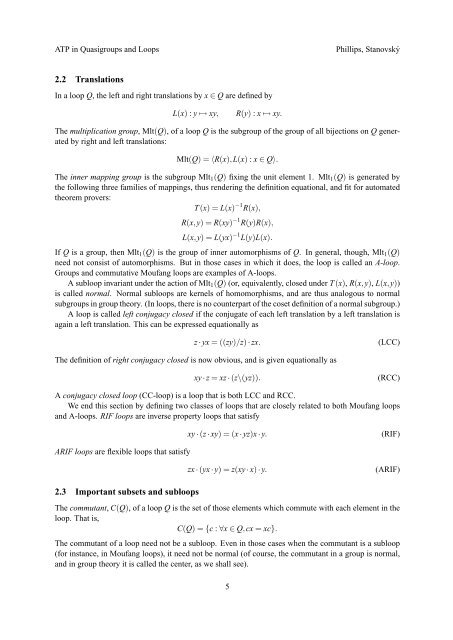Automated Theorem Proving in Quasigroup and Loop Theory
Automated Theorem Proving in Quasigroup and Loop Theory
Automated Theorem Proving in Quasigroup and Loop Theory
You also want an ePaper? Increase the reach of your titles
YUMPU automatically turns print PDFs into web optimized ePapers that Google loves.
ATP <strong>in</strong> <strong>Quasigroup</strong>s <strong>and</strong> <strong>Loop</strong>s<br />
Phillips, Stanovský<br />
2.2 Translations<br />
In a loop Q, the left <strong>and</strong> right translations by x ∈ Q are def<strong>in</strong>ed by<br />
L(x) : y ↦→ xy,<br />
R(y) : x ↦→ xy.<br />
The multiplication group, Mlt(Q), of a loop Q is the subgroup of the group of all bijections on Q generated<br />
by right <strong>and</strong> left translations:<br />
Mlt(Q) = 〈R(x),L(x) : x ∈ Q〉.<br />
The <strong>in</strong>ner mapp<strong>in</strong>g group is the subgroup Mlt 1 (Q) fix<strong>in</strong>g the unit element 1. Mlt 1 (Q) is generated by<br />
the follow<strong>in</strong>g three families of mapp<strong>in</strong>gs, thus render<strong>in</strong>g the def<strong>in</strong>ition equational, <strong>and</strong> fit for automated<br />
theorem provers:<br />
T (x) = L(x) −1 R(x),<br />
R(x,y) = R(xy) −1 R(y)R(x),<br />
L(x,y) = L(yx) −1 L(y)L(x).<br />
If Q is a group, then Mlt 1 (Q) is the group of <strong>in</strong>ner automorphisms of Q. In general, though, Mlt 1 (Q)<br />
need not consist of automorphisms. But <strong>in</strong> those cases <strong>in</strong> which it does, the loop is called an A-loop.<br />
Groups <strong>and</strong> commutative Moufang loops are examples of A-loops.<br />
A subloop <strong>in</strong>variant under the action of Mlt 1 (Q) (or, equivalently, closed under T (x), R(x,y), L(x,y))<br />
is called normal. Normal subloops are kernels of homomorphisms, <strong>and</strong> are thus analogous to normal<br />
subgroups <strong>in</strong> group theory. (In loops, there is no counterpart of the coset def<strong>in</strong>ition of a normal subgroup.)<br />
A loop is called left conjugacy closed if the conjugate of each left translation by a left translation is<br />
aga<strong>in</strong> a left translation. This can be expressed equationally as<br />
z · yx = ((zy)/z) · zx.<br />
(LCC)<br />
The def<strong>in</strong>ition of right conjugacy closed is now obvious, <strong>and</strong> is given equationally as<br />
xy · z = xz · (z\(yz)).<br />
(RCC)<br />
A conjugacy closed loop (CC-loop) is a loop that is both LCC <strong>and</strong> RCC.<br />
We end this section by def<strong>in</strong><strong>in</strong>g two classes of loops that are closely related to both Moufang loops<br />
<strong>and</strong> A-loops. RIF loops are <strong>in</strong>verse property loops that satisfy<br />
xy · (z · xy) = (x · yz)x · y.<br />
(RIF)<br />
ARIF loops are flexible loops that satisfy<br />
zx · (yx · y) = z(xy · x) · y.<br />
(ARIF)<br />
2.3 Important subsets <strong>and</strong> subloops<br />
The commutant, C(Q), of a loop Q is the set of those elements which commute with each element <strong>in</strong> the<br />
loop. That is,<br />
C(Q) = {c : ∀x ∈ Q,cx = xc}.<br />
The commutant of a loop need not be a subloop. Even <strong>in</strong> those cases when the commutant is a subloop<br />
(for <strong>in</strong>stance, <strong>in</strong> Moufang loops), it need not be normal (of course, the commutant <strong>in</strong> a group is normal,<br />
<strong>and</strong> <strong>in</strong> group theory it is called the center, as we shall see).<br />
5
















